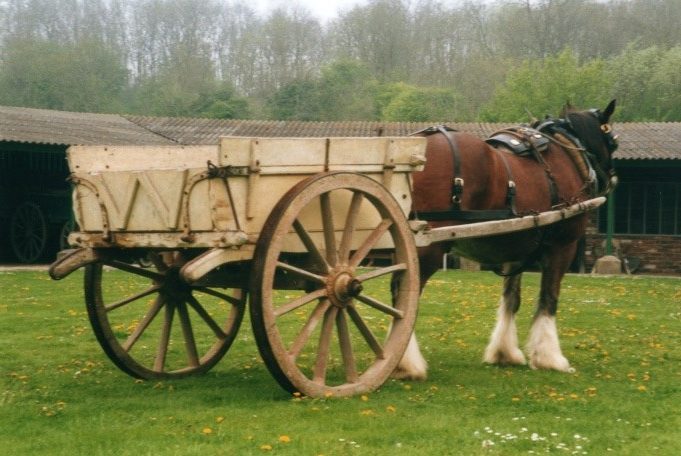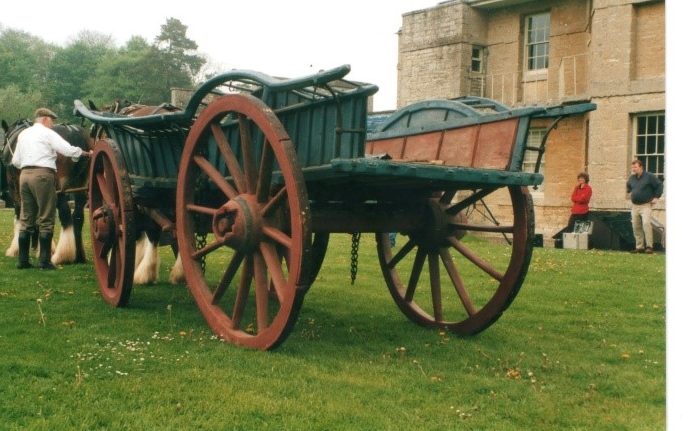Displayed under the sheds at the Old Prison in Northleach, easily accessible through the excellent on-site cafe Relish, is an amazing collection of farm waggons and other farming machinery, essentially of the horse drawn era and into the 1950s. The waggons, tip carts and timber nibs themselves are of regional importance being mostly gathered from the Cotswolds and Vale of Gloucester during the 1960s by Olive Lloyd Baker of Hardwicke Court and passed to Cotswold District Council (CDC) in 1981. The collection has seen some excellent additions of more waggons and thanks to that original preservation work done by professional wheelwrights/carpenters when the museum opened most of them are currently in reasonable if delicate condition.
Around the turn of the millennium, a group of volunteers under the guidance of a freelance conservator gave many hours of hard work to cleaning and preserving the waggons and carts. David Viner (by then retired from his post with CDC Museum Service) and I (Geoff Dubber) also gave time to researching the histories of some them. We talked to several families who remembered their forebears using them, we traced graves of those owners themselves, we located some of the farms where they were used and a couple of the workshops where they were constructed. On one memorable day in May 2000 the Corinium Museum staff, with David Viner’s help, arranged for Richard Gifford, well known Gloucestershire heavy horse enthusiast to bring two of his horses and to harness them to some of the stronger waggons and a tip cart from the collection for a photoshoot. Cameras at the ready, it was a fine sight indeed in spite of the rather dull cloudy weather.
Featured here are LB 512 The ‘Dipper’ Waggon, previously owned by James Dipper of Apperley over in north Gloucestershire and Loan 47 the ‘Webb Tip Cart’, building by Webbs of Cirencester, originally loaned by Lord Vesty and used close to Northleach at Cassey Compton.




In earlier years, to help to preserve the waggons during the cold and damp of the winter months, thin strips of plastic sheeting were hung over the front of the shelters. It was soon realised that the waggons were better if air flowed freely around them. Although under their original covered shelters they are now open to wind and weather all the year. Condensation on both the metal and wood is an issue and in the colder months snow blows in over exposed parts.
In 2017 the process of preservation started again – Corinium Museum staff managed to obtain a small amount of funding and now the ‘Waggon Gang’ of three of us are busy with careful brushing down/sweeping out, cleaning and waxing metal parts and applying other museum preservatives to the wood structures, wheels etc. Ongoing, often fortnightly on a Wednesday morning, occasionally weekly, under the guidance of Corinium Museum staff, we have been working since that date; interrupted for many months by the pandemic. All the waggons, the two carts and two timber nibs were treated, so too some all metal implements, ploughs, skimmers, a grass reaper, a small motorised saw and some cultivators & small seed drills. A little like the Forth Bridge, we have now started again, with a focus on the waggons and carts, this time around giving special attention to the acidic and damaging bird droppings, evidence that the birds (we suspect pigeons are the guilty party !), roost on the waggons when the café is closed and they certainly did so when Covid closed the building for months on end.
Our work will continue in the Spring!
Blog post written by
Volunteers Geoff Dubber. Simon & Sylvia Colbeck










Comments
Hello
My brother and I have inherited eight scale models of agricultural carts representing different regions of southern England. They are very impressive and we are looking for a home for them. Any suggestions? Thanks Martin Lown
Hi Martin, would it be possible to email some images to our Collections Officer Dr Caroline Morris and she will be able to advise. Many thanks carolinemorris@everyoneactive.com
I am trying to email carolinemorris@everyoneactive.com but keep getting delivery failures. Please can I check that this is the correct email address?
Hi Lily please contact Caroline on corinium@freedom-leisure.co.uk thanks